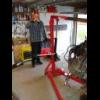This is from the ACL website. I’ve never had an issue doing it this way, of course just as many people have no issues going straight for coolant
http://www.acl.com.a...87?OpenDocument
Q15. Should I add coolant to my newly rebuilt engine?
Answer
Modern high quality coolants are an invaluable necessity in any modern motor. It helps prevent the coolant freezing and boiling and reduces the potential for corrosion of engine components.
The question is often asked: "Should I use ethylene glycol to my newly reconditioned engine?"
Here are a few facts:
The ethylene glycol molecule is a lot more flexible than the water molecule and is therefore able to flow where water can not. This could be along a machine marks in the cylinder head or block.
New generation head gaskets such as MonoTorque have a coating that creates a "cold seal". This cold seal will fill most crevices, although may not get to bottom of any coarse machining grooves.
The temperature created when the new engine is running, allows the microscopic sealing of the head gasket surface coating into surface irregularities.
The fibre construction of some head gasket materials acts as a wick for the glycol to be drawn along until it reaches the exterior edge of the gasket, leaving an unsightly stain along the engine and a loss of coolant.
Materials used in head gaskets today are less likely to "wick" than the past generation materials used.
High quality surface coating used in head gasket manufacturing also provides protection against the ethylene glycol permeating the gasket material.
With these facts in mind the recommended good practice should be:
Fill the cooling system with distilled water.
Start engine, allow motor to reach normal operating temperature carry out standard engine adjustments/checks, test run vehicle.
Stop engine. Allow engine to cool down until the radiator cap can be safely removed and add a good quality coolant (including inhibitor) according to the manufacturer's recommendations.






















